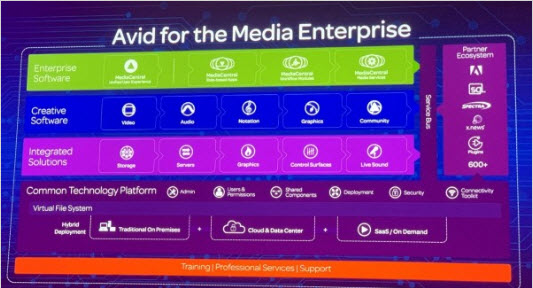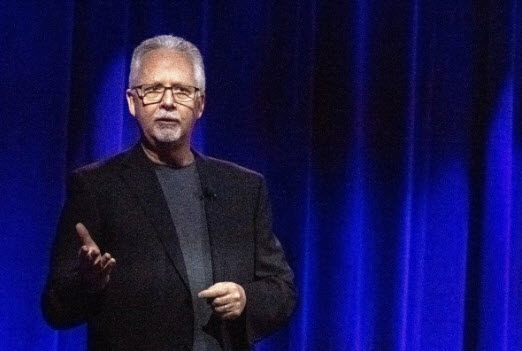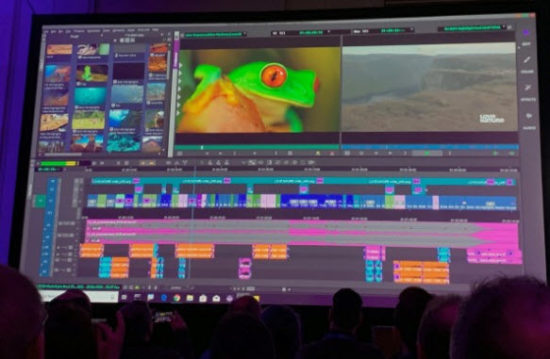Company unveils new products, promises new commitment under new leadership.
Just before NAB last year, the Avid community was shocked by the sudden firing of CEO Louis Hernandez. They were shocked, but it has not been reported that they were saddened. Avid has struggled to negotiate digital transformation and Hernandez was actually one in a line of CEOs who failed to get the Avid machine back on track. He did transition the company to subscription, added collaborative tools, and oversaw a restructuring of the company’s products that the company is moving forward with, at least so far. And, the company has plenty of good news. They’re seeing over 10K new subscriptions for Media Composer per quarter.

Last year, the company introduced Avid First, a new line of free products for people interested in learning Avid tools. The program has been a success with over 1.4 million downloads. Probably more significant, the company finally rolled Avid Link, the successor to Application Manager, which helps fulfill the promise of connectivity for the Avid community Louis Hernandez made years ago. The new app was rolled out in January at NAMM and it is loaded with content as you might expect from a content creation tool maker. The company intends to make Avid Link a central link in their customers’ workflows.

This year, at Avid’s annual user conference, Avid Connect, held concurrently with NAB, CEO Jeff Rosica clearly set out to reset the impressions customers might have about the company. He promised that this time it would be different. He admitted that the company had announced products too early and failed to deliver on time. So, for a start, Rosica promised that everything shown on stage and announced would be shipping in a matter of months, and in fact, many of the products are now available.
The company’s major announcements included enhanced collaboration capabilities with Media Composer and the revamped data management tool Media Central. Avid is also upping its game in storage with seamless cloud access for Nexis.
Media Composer
Central to the news about Media Composer is its integration with Media Central, which puts asset management in the center of the production process where everyone can see and communicate on a project as appropriate. A lot of work can be done in Media Central to prepare clips, data, and assets for editors. On its own, Media Central would be pretty big news but Avid’s update of Media Composer was the big news and it was a big hulking psychic elephant in the room throughout the Avid Connect presentation. It was a relief when Rosica finally turned the presentation to the new Media Composer.
And, when Rosica announced the arrival of a completely revamped Media Composer and a brand-new interface at Connect, its user conference, there was also just the littlest shiver that went through the crowd. Media Composer is the primary work tool for generations of video professionals and people are cautious about changes to the tools they rely on. The company’s slowness in maintaining Media Composer as advance formats have caused some pent-up frustration. In general, though, the changes went over well but that caution still exists.

The major goal of the new Media Composer is to enable users to stay in the program to complete a project and not have to go elsewhere to handle transcoding, or another format, etc. New features make it easier to find, tag, and organize clips. It has a new interface that takes advantage of tabs and panels so users can navigate to the controls they want quickly.
The Avid Media Engine has been revamped with GPU support. It puts more power at a user’s fingertips with features, including support for native MXF OP1a, an important demand from working professionals for broadcast video delivery. In addition, the new Media Composer can handle more video and audio streams. Live Timeline introduced in 2018 continues to be updated, letting editors keep working without stopping playback. Users can zoom in and out on the time frame without stopping, making it easier to know where one is in the playback.
Media Composer also adds background rendering, and a distributed processing add-on option so that every workstation in the facility can be put to work on projects when they’re available.
At Avid Connect, the company announced improved integration for Maestro, Avid’s graphics engine that handles everything from rendering to lower 2/3s graphics. Improved integration, as well as faster rendering, again keeps editors inside the Media Composer environment so they can work faster.
Obviously, the 2019 focus is one saving time for editors who are increasingly called on to get work out fast.
It was also clear that users are going to want the largest monitors they can get and multiple monitors. Even with the streamlining, that has been done to media composer there’s a lot going on the screen. There was a wonderful conversation and demo by the editors who worked on Bohemian Rhapsody. It’s telling that the presenters had trouble seeing the screen as they tried to recreate their work on stage. They were probably not using the latest version, but it was a reminder that video editors benefit from large screens and two screens when they can get them. While the new version of Media Composer still has a crowded screen, the work done with panels goes a long way to helping, letting editors get to the view because people working on the road don’t always have a lot of options on monitors.
What was most important about the new program is that it has been updated with support for the formats being used today and formats that are on the way. One of the major announcements of the day was that Avid has joined the ACES logo program as the first partner in the Editorial Finishing category and that the new version supports IMF (Interoperable Master Format) for OTT delivery and OpenEXR. Avid also announced support for 4K, 8K, and even 16K because why not? The trend is for more. Large formats give filmmakers option and sure help sell storage.
Nexis Cloudspaces
The difference between video editors working at home and editors working in for broadcast and in the enterprise is the need for large scale storage to handle assets, data, vfx, etc. Avid says its new Nexis Cloudspaces enable teams to park projects, sync content, and collaborate. Nexis can be instantly provisioned for bursting to additional storage. The company says existing and new Avid Nexis systems come with a limited time offer of 2 terabytes of cloud storage so that companies can try it out for free.
Pro Tools
All else dims a little bit in comparison to the news around Media Composer and Media Central, but Pro Tools is an important part of Avid’s revenue stream being an industry standard for audio creation. For 2019, Pro Tools is getting 50% more voices in Pro Tools Ultimate and double the MIDI track maximum. Pro Tools 2019 is coming in the second quarter of 2019.
Avid has upgraded its tools across the board but by turning its attention to Media Composer it is addressing the deepest wound to the Avid community. As Avid execs scurried around to expand the business and find new customers, they failed to keep Media Composer up to date with industry standards. At Avid Connect, much was made of the fact that Jeff Rosica “is one of us,” a former laborer in the fields of editing and content creation. The focus of Media Composer this year goes a long way to burnishing Rosica’s cred.
What do we think?
In spite of the troubles being experienced by the Avid company, the Avid content creation tools remain an important standard in the broadcast industry. However, by not taking care of niggly irritations like missing standard support, problematic codecs, etc., the company insured that the customers had to add on tools like Adobe Premiere to the additional features they need for output to formats and transcoding, to name a couple of sore sports. Job one for Avid is to keep its customers from straying.
How well the update does will be evident soon. The company gave away free year-long subscriptions to Media Composer.





